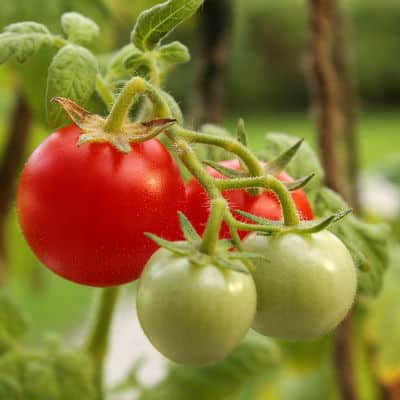Last updated on January 26th, 2022
Our site is reader supported, this means we may earn a small commission from Amazon and other affiliates when you buy through links on our site.
How to grow tomatoes from seed
If you want to grow your own food, one of the easiest types to grow are tomato plants. There are so many different varieties available, from cherry varieties that are ideal for pots and planters to spectacular trailing varieties such as ‘Tumbler’ and ‘Tumbling Tom’. The trailing tomatoes are great for hanging baskets and look out of this world.
Whatever type you grow, there is nothing more rewarding than growing your own tomatoes and then eating the freshly picked tomatoes. One of the easiest and most affordable ways to do this is by growing them from seed. With seeds costing as little as a few pence each, why wouldn’t you try to grow your own?
When to plant tomato seeds
Tomato seeds are best sown indoors (either in your home or in a heated greenhouse). The ideal temperature for sowing tomatoes is in the 70 to 80F (21 to 27C) range, if the temperature is below 50F (10C) they may not germinate or at best, the germination rate will be poor. Ideally, you want to sow seeds indoors around March-April and they should germinate in around 10-14 days. The warmer the conditions, the faster they will germinate.
The aim is to have tomato plants germinated, transplanted and grown into single pots for around the end of May as this is when they can go safely outside because the risk of frost and cold weather has passed.
Quick Tip – Plant seeds around March-April in jiffy plugs or in a seed tray using seed compost.
When to plant tomato seeds outdoors
We have been asked this question many times but the answer is, you don’t generally. You sow seeds indoors and then plant established plants outdoors when they are ready.
How to plant tomato seeds
You can either plant tomato seeds in jiffy plugs (these are small peat pellets that swell when they have been soaked in water to form a small peat plug) and then insert one seed into each jiffy plug. We find this is the easiest way to grow tomatoes from seed because you don’t need to disturb the roots when you transplant the seedling into their individual pots as you pot up the whole peat plug.
The other way to grow them is by sowing multiple seeds into a seed tray or pots, ensuring the seeds are spread far enough apart to make transplanting them easier once they germinate. Sow seeds lightly on the surface of the soil and cover with a thin layer of compost 2-3mm or a thin scatter of perlite.

What compost to use for sowing seeds
Don’t use garden soil to sow seeds, the soil could pass diseases to the seedlings and they usually rot off as the soil is not ideal at all. Use a good quality seed compost that is usually made up of peat and perlite and doesn’t have much fertiliser in it, if any. Seeds do not need fertiliser or feeding as they have all the nutrients they need in the seed and only require food once they have rooted and are transplanted.
Once all your seeds are sown simply water with a fine watering can until the compost is moist, ensure it is not too wet as this can cause the seedlings to rot off.
Once watered, you can either place them in a propagator (with a cover) in a warm position. Many propagators have heating underneath that will speed up germination and generally they will germinate more evenly as well (germinate at the same time).
If you do not have a propagator then cover the plants with clear plastic to keep the soil moist and put some sticks into the seed tray or pot to hold the plastic away from the soil. They should then germinate within around 10-14 days but check daily as you will want to remove the plastic cover as soon as they germinate. Whilst you are waiting for them to germinate, it is not important to give them too much sunlight because they don’t require it, but as soon as they germinate they will need to move to a sunny position.
Important Note – If you don’t move them to a sunny position as soon as they germinate, they will grow 2-3 inches within a few days but will be thin and leggy and not make good, quality plants.
Potting seedlings into individual pots
Once germinated, the first set of leaves the tomatoes will produce is the baby cotyledon leaves. These are followed by the second set of leaves that are known as the ‘true leaves. Once they have the true leaves and are looking nice and strong with healthy roots, they are ready to be transplanted into 9cm (6 inch) pots. This usually takes around 30 days to get to this point but can vary depending on how much sun and light they receive.
We recommend now using quality potting compost with fertiliser and mixing it with approximately 20% perlite because this will help to retain moisture and help with drainage. Some nurseries make their own compost and this may be of better quality, so it is always worth asking if they have their own brand.
Simply fill a small pot with compost and make a small hole in the centre of the compost where the seedling will be planted. If you have grown them in jiffy peat plugs, simply plant the whole plug (roots). Tomatoes can be planted deeper, so we recommend planting down to the first set of leaves. Tomatoes will grow roots from the stem so planting deeper will encourage good strong plants.
If you have grown your seedling in a seed tray or large pot, carefully tease the seedling out of the compost with a dibber or stick ensuring that you do not damage the roots or stems and pot on, as instructed above. Always hold the seedlings by their cotyledon leaves when transplanting to avoid unnecessarily damaging the seedlings.
Growing the tomatoes on
Ensure that tomatoes are kept indoors whilst being grown on, preferably at a temperature of around 70 to 80F (21 to 27C). Once the outside temperature is consistently above 50F (10C) you can start to harden off the plants before they are moved outside for the rest of the summer. Hardening them off means that you put the plants outdoors for a few hours each day to get them used to the outdoor conditions. You increase the number of hours they are outside for over the next few weeks and once the temperature is regularly above 70 to 80F (21 to 27C) you can then plant them outside or into a cold greenhouse.
When they have good strong root systems and stems, (usually around the end of May, early June depending on when you sow the seeds) they can be planted outdoors. They can be planted deeper again so remove the bottom set of leaves and plant to the bottom of the first set of leaves. This will encourage the roots to form from the stem and produce good strong plants.
Watering tomatoes
Tomatoes require lots of water and the aim is to keep the soil moist but not too wet as this can cause them to root rot. Equally, if they are left to become too dry then this can cause ‘blossom end rot’. This is a disease where the bottom of the tomato turns black and the fruit can crack, which is a complete disaster. In summer tomatoes may need watering every day, if not twice a day.
Feeding tomatoes
Feed tomatoes with a balanced feed as instructed by the manufacturer. Once the tomato plants start to flower you need to switch to a high in potash feed, most tomato feeds are ideal. Feed every 10-14 days, this is especially important when the tomatoes are forming.
You can also learn more about how to grow tomatoes in pots here and how to grow them in hanging baskets in this guide here.


